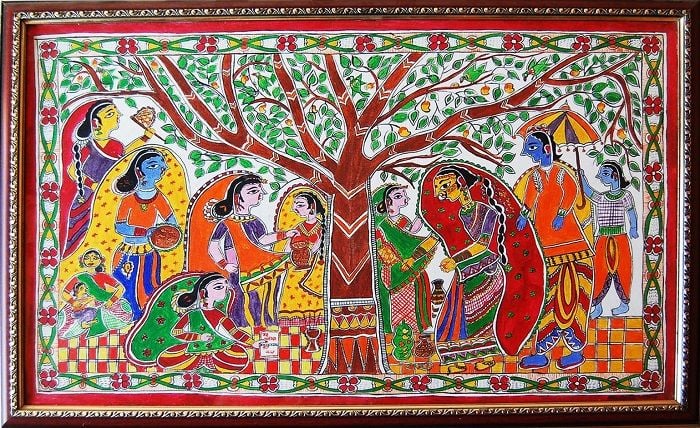Indian Art
Top 5 Madhubani Paintings & Artists: Madhubani Art or Mithila art
Madhubani painting, also known as Mithila art, is a traditional form of art originating from the Mithila region in Bihar, India. It is characterized by intricate designs, vibrant colors, and symbolic representations. Traditionally, this art form adorned the walls of homes, narrating tales from mythology, showcasing rituals, and celebrating nature’s beauty.
Why is Madhubani Painting Special?
Rich Cultural Heritage: Madhubani painting is deeply rooted in the cultural heritage of India, passed down through generations.
Unique Styles and Themes: It encompasses various styles such as Bharni, Kachni, Tantrik, and Godna, each with distinct characteristics, and often depicts themes from nature, mythology, and rituals.
Artistic Techniques: Artists employ natural pigments and meticulous techniques using fingers, twigs, brushes, and nib-pens to create intricate designs on various surfaces.
When Did Madhubani Painting Originate?
The origins of Madhubani painting can be traced back to ancient times, where women in the Mithila region decorated their homes with these intricate designs. Historically, this art form was localized to specific communities and was predominantly practiced by women.
Evolution Over Time
Over the years, Madhubani painting has evolved from being a domestic ritual to a globally recognized art form. It gained prominence in the 1960s when artists started transferring these designs from walls to paper, contributing to its commercialization and widespread recognition.
Noteworthy Facts About Madhubani Painting
Symbolism in Every Stroke: Every element in a Madhubani painting holds symbolic significance. For instance, fish symbolize fertility and prosperity, peacocks represent love and beauty, while lotus ponds signify purity and spiritual awakening.
Geographical Indication (GI) Tag: Madhubani painting received the GI tag in 2008, recognizing its uniqueness and origin from the Mithila region, protecting its authenticity and heritage.
Global Recognition and Adaptation: This art form has transcended geographical boundaries and is adapted into various forms like sarees, wall hangings, pottery, and more, garnering international acclaim.
The Cultural Significance of Madhubani Painting

Madhubani art is not merely about aesthetics; it holds immense cultural significance:
Ceremonial Use: It is often used in festivals, weddings, and other auspicious occasions, symbolizing good luck and prosperity.
Preservation of Tradition: Madhubani painting preserves cultural narratives, myths, and rituals, reflecting the community’s identity and heritage.
Economic Empowerment: The commercialization of Madhubani art has empowered local artists, providing them with livelihood opportunities and preserving their artistic legacy.
Top 5 Madhubani Paintings & Artists: Madhubani Art or Mithila art
Delve into the captivating realm of Madhubani paintings and artists, showcasing the best of Mithila art. Uncover the beauty and storytelling embedded in these top 5 masterpieces, reflecting the traditions and folklore of the region.
1. Sita Devi:

Sita Devi was one of the most famous Madhubani artists. She was known for her use of vibrant colors and intricate patterns. This is a painting by Sita Devi. It shows a woman dancing in the middle of the picture. Two men are playing horns on either side of her. The painting is made with ink and colored paint on paper.

2. Ganga Devi:

Ganga Devi was a pioneer of Madhubani painting. She is known for her unique style, which incorporates elements of folk art and tribal art. Devi was awarded the National Award in 1984. Painting, The Cycle of Life, 1983-85, detail (scenes from the rural life of Mithila).

3. Mahasundari Devi:

Mahasundari Devi was another influential Madhubani artist. She is known for her innovative use of natural dyes and her ability to capture the essence of everyday life in her paintings. Devi received the Padma Shri award, one of India’s highest civilian honors, in 2011.

4. Jagdamba Devi:

Jagdamba Devi was a master of Madhubani painting. She is known for her ability to capture the emotions and expressions of her subjects. Devi was awarded the Padma Shri in 1975.
5. Baua Devi:

Baua Devi was a respected Madhubani artist. She is known for her use of bold colors and simple forms. Devi was awarded the National Award in 1981. recently awarded as Padma Shri in 2017.

Madhubani painting is a vibrant and expressive art form that has been passed down from generation to generation. Today, Madhubani paintings are enjoyed by people all over the world.
Also, Read: Top 10 Jamini Roy Paintings
Conclusion: Embracing the Beauty of Madhubani Art
Madhubani painting stands as a testament to the rich heritage and artistic brilliance of India. Its evolution from wall art to a global phenomenon showcases the timeless appeal and cultural significance embedded in its intricate designs and vibrant colors. The art form continues to captivate art enthusiasts worldwide, transcending boundaries and preserving stories that resonate across generations.
Appreciating Madhubani painting goes beyond admiring its beauty; it’s an exploration of centuries-old traditions and cultural narratives that continue to thrive and inspire in the modern world.

